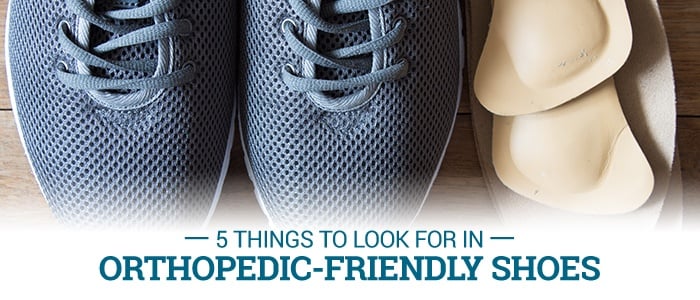
Whether you're accommodating for a temporary or chronic condition, shoes with orthopedic features can be a great tool for improving your foot health. They can go a long way toward treating conditions such as blisters, long-term foot pain, bone spurs or arthritis—all symptoms that can be born out of wearing improper footwear. If you've decided it's time to look for a better shoe, whether by pedorthist recommendation or by personal interest, there are a few things to look for when trying out your options.
Here are five things you should look for in your orthopedic shoe purchase.
Inside Features
When investigating the inner workings of your everyday shoe of choice, it's important to look for a few key elements. Does the insole provide adequate support—is it removable, and does it offer the right amount of cushion for your distinct arch? How about toe room—does it offer the right amount of space to prevent irritation or calluses over time? (Look for round- or square-toed shoes, and avoid shoes that come to a point.) The bottoms of each person's feet can vary widely, so make sure you've taken steps to ensure your individual shape is accommodated for. (Your left foot may even vary from your right!)
You could also benefit from features that you can add to your existing shoes, such as certain inserts and custom-made appliances. For example, some steel flat inserts are used to help with toe pain, some small, custom-made heel lifts can help with planar fasciitis—the list is virtually endless. Talk with an Orthopedic Institute specialist to see if this could work for you.
Are you an avid runner? There are even more considerations to make when it comes to shoes built for joggers. Check out our blog on determining a best-fit shoe!
Outside Features
The comfort and effectiveness of your everyday-use shoes depends on more than just the inner elements. Outer pieces can have a big impact on quality as well. Look for pairs that feature breathable fabric on the top of the shoe for optimum ventilation in warmer conditions. The style of the base of the shoe is also critically important—make sure it features quality tread to keep your contact with the ground stable and balanced.
Adequate Heel
Many shoes feature a slight heel. Depending on your arch and the foot condition you're accounting for, a slight lift can actually help in some cases, such as plantar fasciitis. (Consult with your pedorthist on which heel features are best-fit for you and your condition—depending on what you're accounting for, less heel may be a better idea.) You should also keep your eyes peeled for pairs that have a stable heel counter—the cup that offers structure to the back half of the shoe. A good way to spot this is to test a heel's bendability. If it's difficult to bend, it should provide stable support.
True Fit
This may or may not surprise you, but your feet can experience slight changes in size throughout the day depending on factors such as humidity and temperature. That's why picking the absolute right fit can be so important for someone looking for shoes that maintain quality foot health. Consider trying on pairs in the afternoon or evening hours once your feet have been walked on for several hours and have slightly expanded from use and outside conditions. This also goes for older shoe-buyers—our feet change throughout our lives, so if you're still wearing the same size you wore years ago, it might be time to take updated measurements.
(Pro tip: When pinpointing the best fit, it's important to wear the style of socks you'll most often be utilizing when wearing these shoes—it will give you the truly best idea of the size you should buy.)
Specialization
When it comes to finding quality shoes, it helps to do your homework before you head to the store. While some major footwear manufacturers may offer shoes with joint-healthy support in addition to standard designs, they may not have a true specialization in this style of shoe. Look for companies with good reviews and endorsements of health organizations or manufacturers that solely focus on quality, well-designed and manufactured shoes. It also can't hurt to speak to your pedorthist about best practices when buying. Check out OI's own resident pedorthist, and schedule an evaluation!

